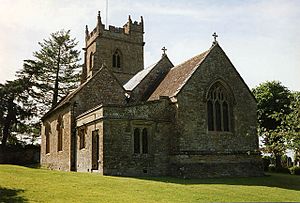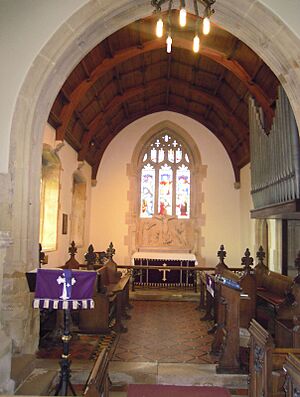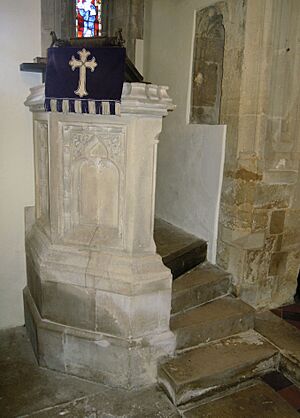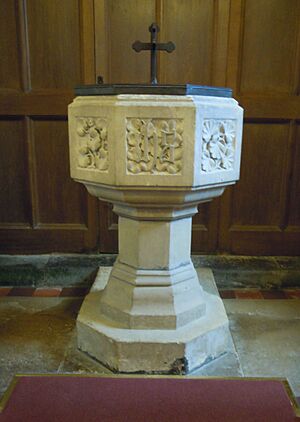Church of St Thomas à Becket, South Cadbury facts for kids

The Church of St Thomas à Becket is a historic church in the old village of South Cadbury in Somerset, England. It is a Church of England church and is named after Thomas Becket. Today, it is part of the 'Camelot Churches' group in South Somerset. This church has been a special Grade II* listed building since 1961, meaning it is very important. It had many repairs and updates in the 1850s and 1870s.
Contents
A Look Inside the Church




How Old Is the Church?
Records from 1086, like the Domesday Book, show there was an important church here even back then. The church is dedicated to Thomas Becket, who was killed at Canterbury Cathedral in 1170. The first known church leader (Rector) in South Cadbury was Peter de Burg in 1265. At that time, many people admired St Thomas. This is why a very old wall painting of a bishop, found in the south part of the church, might be St Thomas himself. This painting was cleaned up in 1984.
Building Materials and Design
The church is built mostly from local stones like cary and lias, with some special Doulting stone details. Most of the church was built in the 1200s and 1400s. However, it had big repairs and updates in 1874. Many of the things you see inside today are from that time.
The church tower was built in the 1300s. It has a small turret, pointy decorations called pinnacles, and gargoyles. Inside the tower are six bells that can be rung together. The church also has a roof from the 1400s with carvings of angels and decorative bumps.
Special Features Inside
The entrance porch has been repaired many times. But the inner and outer doorways, windows, and the arch leading to the chancel (the area around the altar) are from a later style of English Gothic architecture. The arches and columns inside are very old, from around 1280. The columns have a special shape like a four-leaf clover and fancy tops. The arch leading to the tower is also from this time.
In 1780, a gallery (a raised seating area) was moved. The Mary and Martha Window remembers Rev. James Arthur Bennett. He was the church leader from 1866 to 1890. He helped make the 1874 repairs very successful.
The chancel area was completely rebuilt in 1874. Two windows on the north side were kept as much as possible. The large window at the east end of the church was changed in the early 1800s. The current East Window is from the 1874 repairs. Its glass shows the Ascension (Jesus going to heaven) and was made by Clayton and Bell. All the glass from that time in the church is by them. The beautiful carving of the Crucifixion Scene above the altar was put there in 1870 and was made by Thomas Earp.
The pulpit (where the preacher stands) is made of Bath stone and was carved for the 1874 repairs. One piece from an older pulpit was used as a model for the ends of the pews (church benches) in the main part of the church, called the nave. Most of the wood in the church is from this time, except for the tower door and screen.
A small opening called a squint or hagioscope in the south chancel arch allowed people to see the altar during church services. The baptismal font (a basin for baptisms) was placed in the church in 1871. An older pewter bowl was used for baptisms for many years until it was stolen in 1991.
The south part of the church was rebuilt in 1853. It still has a 14th-century piscina (a basin for washing sacred vessels). The roof of the nave is from the 1400s and has been repainted. The roof in the chancel was built in 1874.
Famous Connections
The 18th-century poet and writer Charles Churchill once worked as a curate (a church assistant) at South Cadbury.

